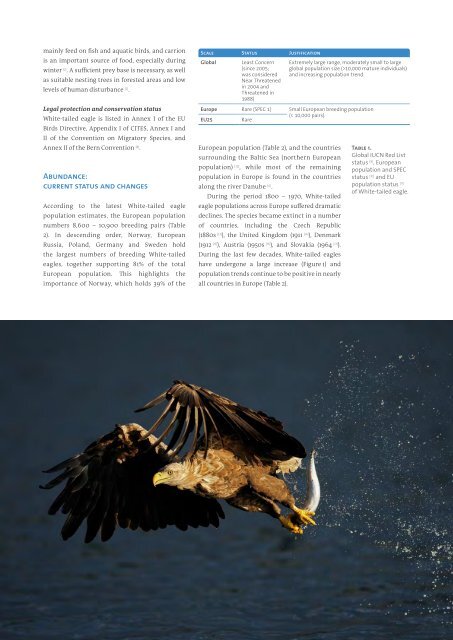130925-studie-wildlife-comeback-in-europe
Create successful ePaper yourself
Turn your PDF publications into a flip-book with our unique Google optimized e-Paper software.
ma<strong>in</strong>ly feed on fish and aquatic birds, and carrion<br />
is an important source of food, especially dur<strong>in</strong>g<br />
w<strong>in</strong>ter [2] . A sufficient prey base is necessary, as well<br />
as suitable nest<strong>in</strong>g trees <strong>in</strong> forested areas and low<br />
levels of human disturbance [2] .<br />
Legal protection and conservation status<br />
White-tailed eagle is listed <strong>in</strong> Annex I of the EU<br />
Birds Directive, Appendix I of CITES, Annex I and<br />
II of the Convention on Migratory Species, and<br />
Annex II of the Bern Convention [8] .<br />
Abundance:<br />
current status and changes<br />
Accord<strong>in</strong>g to the latest White-tailed eagle<br />
population estimates, the European population<br />
numbers 8,600 – 10,900 breed<strong>in</strong>g pairs (Table<br />
2). In descend<strong>in</strong>g order, Norway, European<br />
Russia, Poland, Germany and Sweden hold<br />
the largest numbers of breed<strong>in</strong>g White-tailed<br />
eagles, together support<strong>in</strong>g 81% of the total<br />
European population. This highlights the<br />
importance of Norway, which holds 39% of the<br />
Scale Status Justification<br />
Global<br />
Least Concern<br />
(s<strong>in</strong>ce 2005;<br />
was considered<br />
Near Threatened<br />
<strong>in</strong> 2004 and<br />
Threatened <strong>in</strong><br />
1988)<br />
Extremely large range, moderately small to large<br />
global population size (>10,000 mature <strong>in</strong>dividuals)<br />
and <strong>in</strong>creas<strong>in</strong>g population trend.<br />
Europe Rare (SPEC 1) Small European breed<strong>in</strong>g population<br />
EU25<br />
Rare<br />
(< 10,000 pairs).<br />
European population (Table 2), and the countries<br />
surround<strong>in</strong>g the Baltic Sea (northern European<br />
population) [12] , while most of the rema<strong>in</strong><strong>in</strong>g<br />
population <strong>in</strong> Europe is found <strong>in</strong> the countries<br />
along the river Danube [6] .<br />
Dur<strong>in</strong>g the period 1800 – 1970, White-tailed<br />
eagle populations across Europe suffered dramatic<br />
decl<strong>in</strong>es. The species became ext<strong>in</strong>ct <strong>in</strong> a number<br />
of countries, <strong>in</strong>clud<strong>in</strong>g the Czech Republic<br />
(1880s [13] ), the United K<strong>in</strong>gdom (1911 [14] ), Denmark<br />
(1912 [15] ), Austria (1950s [16] ), and Slovakia (1964 [17] ).<br />
Dur<strong>in</strong>g the last few decades, White-tailed eagles<br />
have undergone a large <strong>in</strong>crease (Figure 1) and<br />
population trends cont<strong>in</strong>ue to be positive <strong>in</strong> nearly<br />
all countries <strong>in</strong> Europe (Table 2).<br />
Table 1.<br />
Global IUCN Red List<br />
status [9] , European<br />
population and SPEC<br />
status [10] and EU<br />
population status [11]<br />
of White-tailed eagle.<br />
223


